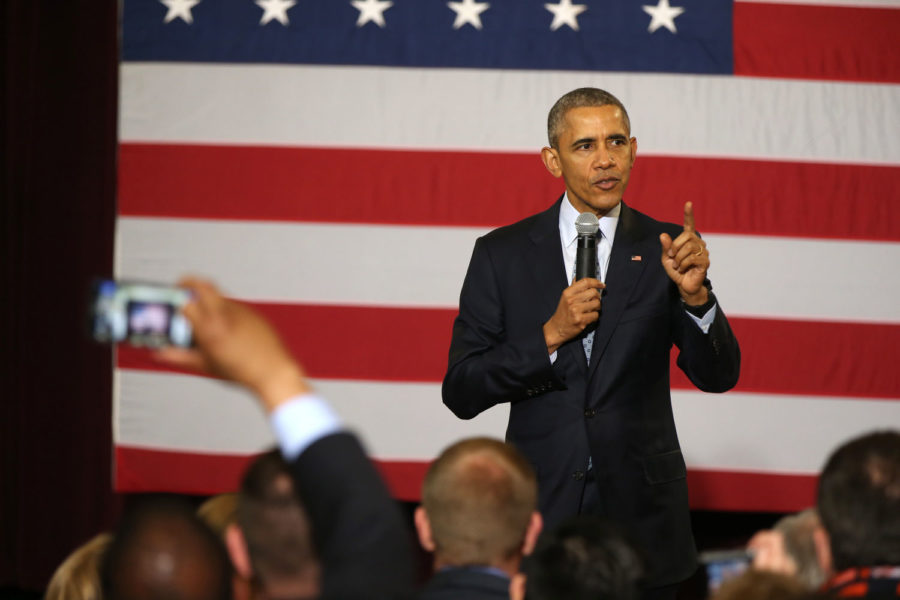Uninsured rate drops again in Illinois after Obamacare takes effect
President Barack Obama stops at the Hoogland Center for the Arts in Springfield following his speech at the Illinois State Capitol on Feb. 10. (TNS)
September 14, 2016
The number of Illinois residents without health insurance dipped below the 1 million mark last year after implementation of the Affordable Care Act, according to Census Bureau data released Tuesday.
About 900,000 Illinoisans, or 7.1 percent of state residents, lacked health insurance in 2015. That’s down from 1.2 million uninsured in 2014 and far fewer than the 1.6 million who were without insurance in 2013, before many provisions of the Affordable Care Act took effect.
The Affordable Care Act, also known as Obamacare, requires all Americans to have health insurance or pay a fine and bars insurers from denying coverage because of pre-existing conditions. Nationally, 9.4 percent of Americans were uninsured in 2015, down from 14.5 percent in 2013.
Advertisement
The law also led to the creation of online marketplaces, or exchanges, where individuals can buy health insurance and often receive tax credits to offset the costs of that coverage.
A number of states, including Illinois, also expanded Medicaid, a safety net health insurance program funded by state and federal dollars, under the law. Given where Illinois was just a few years ago, the numbers are cause for celebration, said Kathy Waligora, director of the health reform initiative of EverThrive Illinois, a maternal and child health advocacy organization.
“This is exactly what we’ve been working toward for six years now,” Waligora said. “It’s exciting to be at a point now where we’re really starting to see the fruits of that labor.”
Jonathan Gold, a spokesman for the U.S. Department of Health and Human Services, also touted the data.
“Before the ban on discrimination based on pre-existing conditions and the tax credits made available through the ACA, coverage was unattainable for millions of Americans, and real comparison shopping was all but impossible,” Gold said in an emailed statement.
The department previously said that 7.9 percent of Illinoisans lacked insurance in 2015. That number doesn’t include older adults eligible for Medicare, whereas the Census number does.
The Census figure is a bright spot amid a series of disappointments for Illinois residents who buy health insurance through the exchange.
Advertisement*
The Illinois Department of Insurance recently submitted to the federal government rate increases ranging from averages of 43 to 55 percent for some types of plans that will be offered on the exchange next year. The federal Centers for Medicare & Medicaid Services will finalize those rates.
Also, a number of insurers have abandoned the exchange in Illinois because of financial losses. Land of Lincoln, Aetna and UnitedHealthcare will no longer offer individual plans on the exchange next year, though Cigna will begin offering individual exchange plans in Illinois next year. Consumers in Lake and McHenry counties shopping for individual plans on the exchange next year will likely only have one choice of insurer.
Consumers in Cook County will likely have four from which to choose. Those in DuPage County will likely have three choices of insurers, and those in Kane and Will counties will likely have two choices.
Phil Lackman, CEO of the Independent Insurance Agents of Illinois, believes the uninsured rate in Illinois will bottom out and might even start to creep back up.
“There’s fewer choices, the prices of the plans are going up, and that’s going to impact everyone whether you’re getting subsidies or not,” Lackman said.
Sarah Hester, a Round Lake computer programmer who buys insurance on the exchange, said her family doesn’t qualify for much in tax credits because of the family’s income level.
About 25 percent of Illinoisans on the exchange don’t get the credits.
Hester and her husband are expecting their first child in November, and their monthly premium is already almost as high as their rent.
“For me personally, I feel like especially with a baby on the way, it’s really not an option to go without,” Hester said.
She knows, however, that those without immediate medical needs might feel differently about buying insurance. Hester didn’t have health insurance for two years when she was younger because she feared paying high premiums.
Still, others are optimistic that Illinois’ uninsured rate will continue to shrink.
“While the marketplace has been open three years now, it’s easy to forget we’re still in a transition,” said EverThrive Illinois’ Waligora. “Implementing any sort of meaningful change takes time.”
Gold noted that even with potentially higher premiums, most Illinoisans who buy insurance on the exchange will spend less than $75 a month for coverage after tax credits. Sabrina Corlette, a research professor at Georgetown University’s Center on Health Insurance Reforms, said she also expects progress can be made nationwide.
“I do think with aggressive outreach and enrollment efforts we can make a much bigger dent than we have in the uninsured rate,” Corlette said.
According to the Census Bureau, 26-year-olds had the highest uninsured rate nationally at 19.5 percent in 2015. That’s the age at which insurers no longer have to cover young adults under their parents’ insurance policies.
___
(c) 2016 the Chicago Tribune
Visit the Chicago Tribune at www.chicagotribune.com
Distributed by Tribune Content Agency, LLC.
Advertisement









